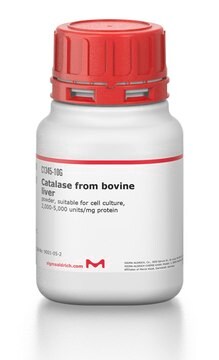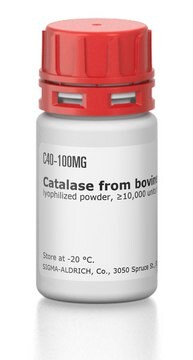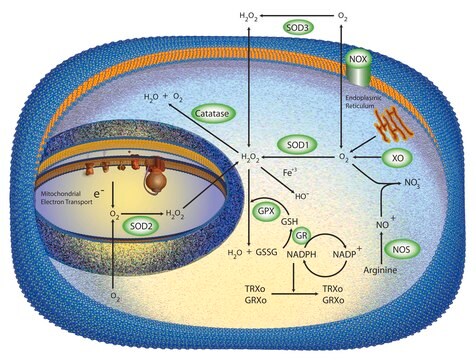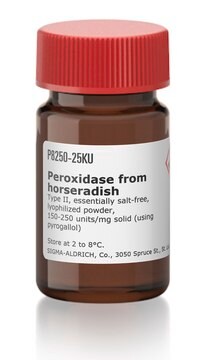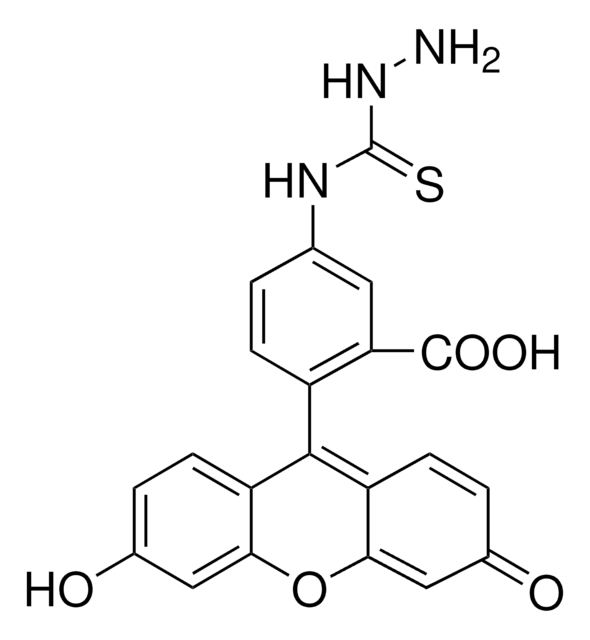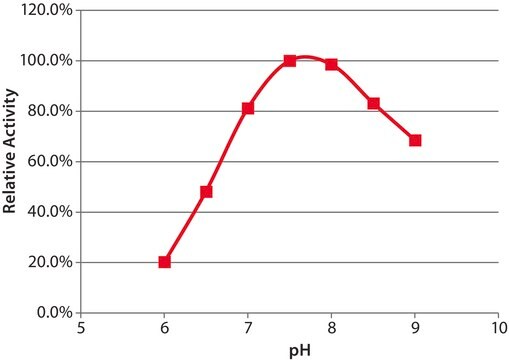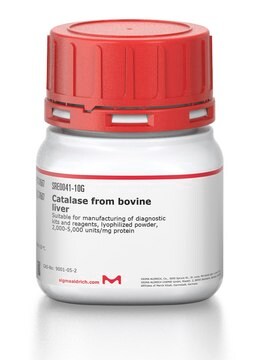Alle Fotos(3)
Wichtige Dokumente
G7400
Galactose-Oxidase aus Dactylium dendroides
lyophilized powder, ≥3,000 units/g solid
Synonym(e):
D-Galactose:oxygen 6-oxidoreductase
Anmeldenzur Ansicht organisationsspezifischer und vertraglich vereinbarter Preise
Alle Fotos(3)
About This Item
Empfohlene Produkte
Biologische Quelle
fungus (Dactylium dendroides)
Qualitätsniveau
Form
lyophilized powder
Spezifische Aktivität
≥3,000 units/g solid
Lagertemp.
−20°C
Suchen Sie nach ähnlichen Produkten? Aufrufen Leitfaden zum Produktvergleich
Allgemeine Beschreibung
Galactose oxidase is an extracellular copper-containing enzyme, secreted by the deuteromycete fungus Dactylium dendroides. It catalyzes the oxidation of a range of primary alcohols, including D-galactose, to the corresponding aldehyde, with reduction of oxygen to hydrogen peroxide.
Anwendung
Galactose oxidase may be used as an analytical tool for the specific determination of D-galactose in blood plasma, plant extracts, and phospholipids. It could be used for the characterization of terminal D-galactoside units in several polymers.
Biochem./physiol. Wirkung
Galactose oxidase catalyzes the coversion of D-galactose to D-galacto-hexodialdose.
2-Deoxy-D-galactose, lactose, melibiose, raffinose and stachyose react with galactose oxidase in the peroxidase:o-tolidine system.
Essentially no oxidation of D-glucose, L-galactose, L-arabinose or D-glucuronate has been observed.
2-Deoxy-D-galactose, lactose, melibiose, raffinose and stachyose react with galactose oxidase in the peroxidase:o-tolidine system.
Essentially no oxidation of D-glucose, L-galactose, L-arabinose or D-glucuronate has been observed.
Einheitendefinition
1 U produziert eine ΔA425 von 1.0 pro Minute bei pH 6.0 und 25 °C in einem Peroxidase und o-Tolidin System. Reaktionsvolumen = 3.4 mL. Lichtweg = 1 cm.
Inhibitor
Produkt-Nr.
Beschreibung
Preisangaben
Ähnliches Produkt
Signalwort
Danger
H-Sätze
P-Sätze
Gefahreneinstufungen
Resp. Sens. 1
Lagerklassenschlüssel
11 - Combustible Solids
WGK
WGK 1
Flammpunkt (°F)
Not applicable
Flammpunkt (°C)
Not applicable
Hier finden Sie alle aktuellen Versionen:
Besitzen Sie dieses Produkt bereits?
In der Dokumentenbibliothek finden Sie die Dokumentation zu den Produkten, die Sie kürzlich erworben haben.
Kunden haben sich ebenfalls angesehen
Bei Yue et al.
Frontiers in pharmacology, 12, 774560-774560 (2021-11-20)
Irinotecan (CPT11), a broad-spectrum cytotoxic anticancer agent, induces a series of toxic side-effects. The most conspicuous side-effect is gastrointestinal mucositis, including nausea, vomiting, and diarrhea. A growing body of evidence indicates that bacteria β-glucuronidase (GUS), an enzyme expressed by intestinal
M J McPherson et al.
The Journal of biological chemistry, 267(12), 8146-8152 (1992-04-25)
The gaoA gene, encoding the secreted copper-containing enzyme galactose oxidase, has been isolated from the Deuteromycete fungus Dactylium dendroides. Degenerate oligonucleotide primers were designed from amino acid sequence data for use in the polymerase chain reaction. A 1.4-kilobase DNA fragment
Takeshi Ito et al.
Talanta, 85(1), 707-712 (2011-06-08)
We proposed a low cost fabrication procedure of a poly(methylmethacrylate) (PMMA) column chip. 3D microchannel structure consisting of four columns in a chip for a mother die was fabricated using dry film photoresist and photolithography technique. Electroforming was applied to
Avgousta Ioannou et al.
Chemical communications (Cambridge, England), 47(40), 11228-11230 (2011-09-15)
Galactose oxidase (GOase) was shown to oxidise several C2/C3 fluorinated galactose analogues. Interestingly, the enzyme was able to distinguish between the 2,3-tetrafluorinated galactose and its epimeric glucose analogue, and this represents the first reported biotransformation of a heavily fluorinated sugar.
Fabio Aparecido Cordeiro et al.
Journal of basic microbiology, 50(6), 527-537 (2010-11-16)
Galactose oxidase (GO) converts galactose to an aldehyde and has several biotechnological applications, including cancer diagnosis. It is mainly produced by Fusarium austroamericanum but is also produced by Fusarium acuminatum and by isolates of the Fusarium graminearum and Gibberella fujikuroi
Unser Team von Wissenschaftlern verfügt über Erfahrung in allen Forschungsbereichen einschließlich Life Science, Materialwissenschaften, chemischer Synthese, Chromatographie, Analytik und vielen mehr..
Setzen Sie sich mit dem technischen Dienst in Verbindung.


